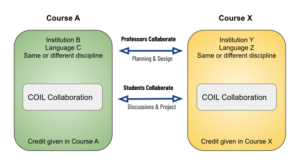A COIL Module includes the following elements:

Choosing a Shared Topic
Each COIL exchange is centered around a shared topic that fits into each class’s curriculum. The topic should provide opportunities for each class to share elements of their culture with the other class and for student collaboration.
Some examples of possible shared topics include:
- Causes and impacts of gentrification in each city
- Criminal justice reform in …
Pre-Exchange Activities
Before beginning a COIL exchange, it’s important to prepare your students for intercultural/international virtual communication. Consider spending some class time covering the following topics:
- Working against assumptions about the Other
- Chimamanda Ngozi Adichie’s The Danger of a Single Story
- Introducing the other country
- Digital behavior to facilitate respectful dialogue and cultivate the culture of mutual respect
Three Classic Activities of a COIL Module
Ice Breaker
This is the first activity which involves the students from each class and can be done individually, as a home team, or as a binational team. The icebreaker acts to introduce the students to each other: their home classmates; and the students in the international class. An added benefit is that it enables the professors to become familiar with students both in their respective class and in the international class, which has added importance given the remote nature of the collaboration and the possibility that the courses will be taught in the remote mode. Since classes, especially in the US, may be composed of students from diverse cultures, providing a mechanism for students to explore questions about their lives, facilitates student reflection on their own culture and learning about the culture of their home classmates and the international students. This can lead to greater understanding, empathy, and ultimately cross-cultural competency.
Examples:
- Creating a short post that shares a story about your name.
- Uploading a short video to a shared virtual space in which students answer questions designed by faculty individually as a home team or as a binational team.
- Displaying photographs taken by student of the student’s daily life etc. or a media montage of student’s culture
- Commenting on the video, photographs, or montage of students in binational team or in international class
- Displaying poetry or prose which reflect the student’s culture.
Questions:
- Student’s name
- University or college attending
- Major or program
- Family structure/Siblings
- Hobbies
- Favorite music/bands/type of music
- Extracurricular activities
- Foods they enjoy
Comparative Analysis
The comparative analysis activity represents the heart of the COIL project and provides the mechanism for the students to achieve cross-cultural competencies. The students analyze the differences and similarities of the cultures through the theme that the course is exploring. There are a multitude of ways to facilitate the comparison and the analysis. This is normally done in binational teams composed of at least 2 students from each class. Students develop career competencies in teamwork; cross-cultural awareness; critical thinking; and digital skills.
Examples:
- Home country classmates (of binational teams) conduct research about the topic in their respective culture and create a lesson to teach the international students in their binational teams. The students can discuss the similarities and differences. The lesson and discussion is recorded and uploaded to shared virtual space.
- Students read/watch several texts assigned by instructors about how a shared topic manifests in each country and participate in comparative discussions with international peers synchronously or asynchronously
- Students take photos representing a shared topic in each country and compare/contrast
- Students look for articles on a shared topic from local newspaper or media and compare/contrast
Collaborative Project
Following the Comparative Analysis assignment, students from both countries should collaborate on a project that will require them to tackle at least one part of the shared topic together through (a) concrete task(s).
In this activity, student work is created. When students partake in activities independent of faculty, their learning is often deepened. Faculty can require a certain project that the students in teams undertake or students can collaboratively choose the media through which they will represent their new knowledge and they collaboratively create the product. Oftentimes the product is presented by the team to a wider audience and one student takes the initiative to lead the endeavor. The important ingredient in this activity is that the students must collaborate across cultures. The project should provide students with an opportunity to negotiate differences of opinion and reach consensus, learn from each other to create a product. Since collaboration is a difficult process even among people who share the same culture, this activity yields tremendous benefits. Students develop career competencies in teamwork: cross-cultural awareness; critical thinking: digital skills; leadership: and professionalism.
Example of a Collaborative Project:
- Powerpoint presentation
- video
- public service announcement
- podcast
- montage of photographs that depict similarities and differences of theme in respective cultures
- App
- Infographic
- Report on the water contamination in both countries-similarities and differences.
Elements of this page adapted from the GSACS Faculty Guide.

